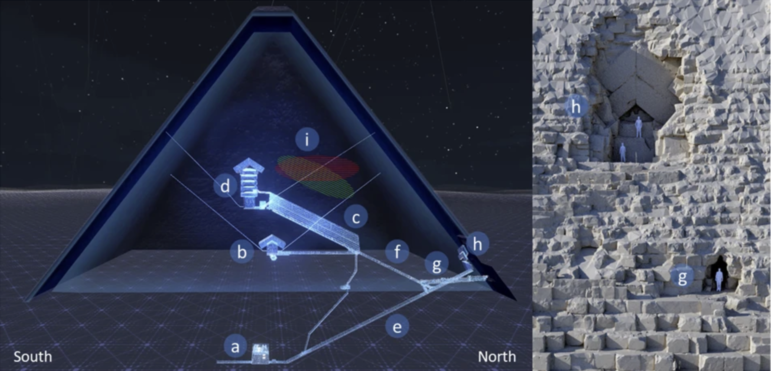CAIRO – New scanning technology has revealed a previously unknown chamber in the Pyramid of Khufu, the largest of the three Great Pyramids of Giza, according to Egypt’s Supreme Council of Antiquities. Egyptian archaeologist Zahi Hawass and the country’s Minister for Tourism Ahmed Eissa, announced the discovery Thursday at an unveiling ceremony outside the pyramid.
The discovery is credited to the ScanPyramids Project, which has been using state-of-the-art, non-invasive scanning techniques to learn about the interior of the pyramids since 2015. In 2016 and 2017, ScanPyramids used an innovative process involving cosmic ray muon radiography to make the initial discovery of this and other corridors.

An early photograph of the Great Pyramid, taken by Frédéric Goupil-Fesquet in 1839 [public domain]
One of the members of the project, Christian Grosse, a professor of non-destructive testing at the Technical University of Munich, described how the team used ultrasound and ground-penetrating radar to follow up on the initial muon radiographic study.
’’There are two large limestones at the end chamber, and now the question is what’s behind these stones and below the chamber,” Grosse said.
The corridor is right above the main entrance to the pyramids but is sealed off from the rest of the interior. The space measures about nine meters by two meters – about 180 square feet.
Non-destructive methods like these are essential for studying the Great Pyramid because of the need to preserve the structure.
“It’s the Great Pyramid, we can’t touch it,” said Mohamed Ismail, a spokesman for the Egyptian Ministry of Antiquities, according to CNN. “Even if it is a different team with the same technology, any intrusive technique is out of the question.”
This aim toward preservation is a modern commitment. In the Middle Ages, the Abbasid caliph al-Ma’mun had a tunnel bored into the pyramid, now used as the main tourist entrance, and in 1837 the British Egyptologist Howard Vyse discovered the four “relieving chambers” above the King’s Chamber by boring a hole with gunpowder.

Detail of the north side of the Cheops pyramid, located on the Giza plateau near Cairo, Egypt. The newly discovered corridor is behind this chevron. [Olaf Tausch, Wikimedia Commons, CC 3.0]
Those relieving chambers, along with the newly-discovered sealed corridor, were used to redistribute weight in the construction of the pyramid. It is not believed that this corridor, nor any other identified sealed space in the Great Pyramid, holds another burial chamber.
“There is no scientific, archaeological or historical evidence that corroborates this,” Ismail said. “If there is another burial chamber, there would have been an entrance to it.”
There are three main chambers inside the Great Pyramid: the King’s Chamber, the smaller Queen’s Chamber, a subterranean chamber, along with the Grand Gallery.

A visualization of the interior of the Great Pyramid from ScanPyramids. a: Subterranean chamber; b: queen’s chamber; c: grand gallery; d: king’s chamber; e: descending corridor; f: ascending corridor; g: al-Ma’mun corridor; h: north face Chevron area; i: ScanPyramids Big Void with horizontal hypothesis (red hatching) and inclined hypothesis (green hatching) as published in November 2017. All these images were obtained from a 3D modelization using dedicated laser surveys and photogrammetry data. The diagram does not display the new corridor, which would be above section h. [Procureur, S., Morishima, K., Kuno, M. et al., CC 4.0]
The Great Pyramid was ordered to be constructed by Khufu, a pharaoh in ancient Egypt’s Fourth Dynasty, during the Old Kingdom period, about 4600 years ago. It is the oldest of the three main pyramids at Giza, and has dazzled travelers for millennia; famously, it is the last surviving of the Seven Wonders of the ancient world. At 146 meters – 139 today, following centuries of erosion and looting – it was the tallest building constructed by humans until the Eiffel Tower in the 19th century.
The Wild Hunt is not responsible for links to external content.
To join a conversation on this post:
Visit our The Wild Hunt subreddit! Point your favorite browser to https://www.reddit.com/r/The_Wild_Hunt_News/, then click “JOIN”. Make sure to click the bell, too, to be notified of new articles posted to our subreddit.
